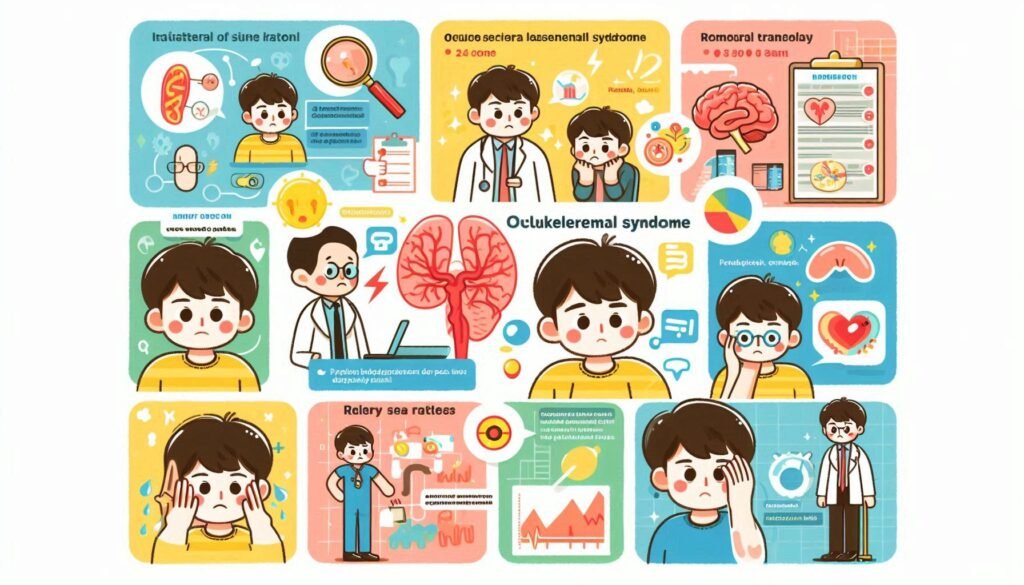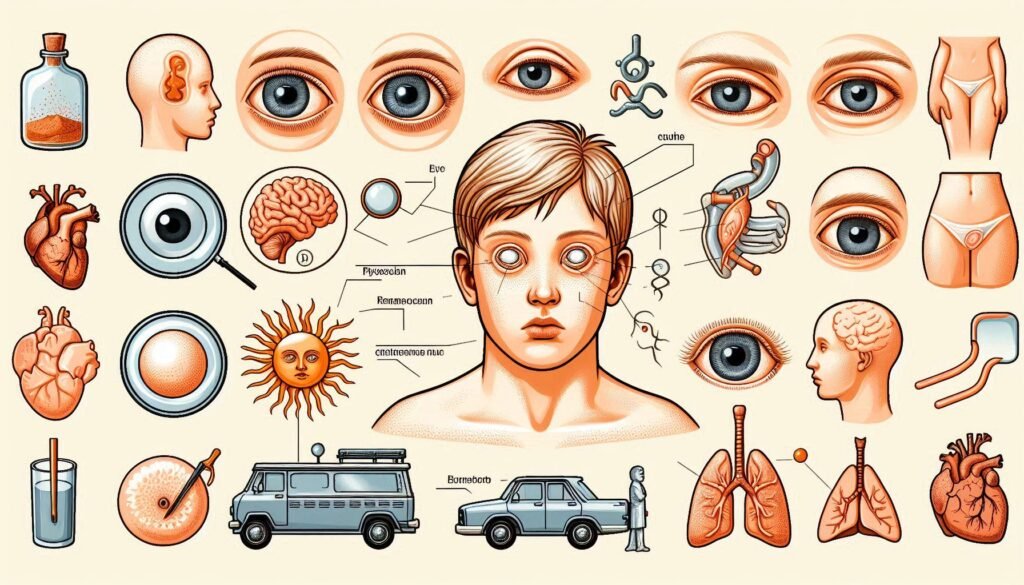Oculocerebrorenal Syndrome, commonly known as Lowe syndrome, is a rare genetic condition that affects multiple systems in the body. This X-linked disorder often poses complex challenges for those who are diagnosed and their families. As we delve into this intricate genetic landscape, it’s crucial to understand its primary features, including ocular, neurological, and renal manifestations.
Awareness of Lowe syndrome can empower patients and caregivers alike while fostering empathy and understanding within the community. Let’s explore what you need to know about this multifaceted condition and how it impacts daily life.
Oculocerebrorenal Syndrome of Lowe: A Rare X-Linked Disorder
Oculocerebrorenal Syndrome, or Lowe syndrome, is a rare genetic disorder predominantly affecting males. It arises due to mutations in the OCRL gene located on the X chromosome. This unique inheritance pattern means that females can be carriers but often display milder symptoms.
“What Are The Signs of Waardenburg Syndrome?”
The condition was first described in 1961 and is characterized by a triad of symptoms: ocular abnormalities, neurological issues, and renal dysfunction. These multi-systemic manifestations make diagnosis challenging for healthcare professionals.
Children with this syndrome typically present at birth or during early childhood, prompting families to seek specialized care. Understanding its genetic basis is vital for proper management and support throughout life’s journey with Lowe syndrome.

OCRL Gene: Mutations and Their Impact on Cell Function
The OCRL gene plays a crucial role in cell function, specifically in the regulation of phosphoinositides. Mutations within this gene disrupt normal cellular processes, leading to significant health issues. These mutations are linked directly to Oculocerebrorenal Syndrome.
“Why Does Walker-Warburg Syndrome Affect Brain Development?”
When the OCRL gene is altered, it can affect various pathways essential for cell signaling and morphology. This disruption contributes to the clinical manifestations observed in patients with Lowe syndrome. Understanding these genetic changes helps elucidate how they impact overall health.
Research continues to explore targeted therapies aimed at correcting or compensating for these mutations. Advances could pave the way for innovative treatments that address both symptoms and underlying causes of this rare disorder.
Clinical Triad: Ocular, Neurological, and Renal Manifestations
Oculocerebrorenal Syndrome, also known as Lowe Syndrome, is characterized by a clinical triad of ocular, neurological, and renal manifestations. Each component plays a crucial role in identifying the disorder early.
“How Does Weaver Syndrome Impact Growth?”
The ocular features often include congenital cataracts and glaucoma. These vision problems can lead to significant visual impairment if not promptly addressed.
Neurological complications typically involve hypotonia, intellectual disability, and seizures. These challenges affect motor skills and cognitive development throughout life.
Renal involvement manifests as Fanconi syndrome with tubular dysfunction. This leads to issues like electrolyte imbalances and nutrient losses that require careful management for optimal health outcomes.
Ophthalmological Features: Congenital Cataracts and Glaucoma
Oculocerebrorenal syndrome often presents with significant ophthalmological features. Congenital cataracts are among the most common eye abnormalities seen in affected individuals. These cataracts typically develop early in life, sometimes even at birth, affecting vision and requiring prompt intervention.
“What Causes Williams Syndrome? Complete Guide”
Glaucoma is another serious concern linked to this condition. Raised intraocular pressure can lead to optic nerve damage if not managed properly. Children may experience symptoms like redness or excessive tearing, but many remain asymptomatic until advanced stages.
Early diagnosis and treatment of these ocular issues are crucial for preserving sight. Regular comprehensive eye examinations help monitor and address any emerging complications associated with oculocerebrorenal syndrome effectively.
Neurological Aspects: Hypotonia, Intellectual Disability, and Seizures
Individuals with Oculocerebrorenal Syndrome often exhibit hypotonia, a condition characterized by decreased muscle tone. This can lead to difficulties in movement and coordination during early development. Parents may notice that their child seems unusually floppy or has challenges holding up their head.
“Why Does WAGR Syndrome Affect Multiple Systems?”
Intellectual disability is another significant aspect of the syndrome. Cognitive impairments vary widely among affected individuals, impacting learning abilities and daily functioning. Early intervention programs can help support cognitive development.
Seizures are also prevalent in those with Lowe syndrome. These neurological episodes can range from mild to severe and may require careful management through medication. Monitoring and tailored care are essential for improving the quality of life for affected individuals.
Renal Tubular Dysfunction: Fanconi Syndrome in Lowe Syndrome
Renal tubular dysfunction is a hallmark of Oculocerebrorenal Syndrome, often presenting as Fanconi syndrome. This condition affects the kidneys’ ability to reabsorb vital nutrients and electrolytes. As a result, patients may experience significant losses of glucose, amino acids, phosphate, and bicarbonate.
“How Does Warfarin Embryopathy Syndrome Develop?”
The impaired renal function leads to various complications such as metabolic acidosis and rickets. These challenges can significantly impact growth and overall health in affected individuals. Monitoring kidney function is crucial for early detection of these issues.
Management includes supportive care aimed at correcting electrolyte imbalances and nutritional deficiencies. Regular follow-ups with nephrologists ensure that interventions are tailored to each patient’s needs while addressing potential complications proactively.
Diagnostic Approaches: Clinical Evaluation and Genetic Testing
Diagnosing Oculocerebrorenal Syndrome often begins with a thorough clinical evaluation. Healthcare professionals assess the patient’s medical history and physical symptoms, focusing on ocular, neurological, and renal manifestations.
Genetic testing plays a crucial role in confirming the diagnosis. It typically involves analyzing DNA to identify mutations in the OCRL gene, which is responsible for Lowe syndrome. This process can provide definitive information about the disorder.
“What Triggers Weber-Christian Disease Syndrome?”
Early detection through these diagnostic approaches allows for timely intervention and management of symptoms. An accurate diagnosis helps families understand their options and prepares them for future challenges related to this complex condition.
Ocular Management: Cataract Surgery and Vision Rehabilitation
Cataract surgery is often a critical intervention for individuals with Oculocerebrorenal Syndrome. Congenital cataracts can significantly impair vision from an early age, making timely surgical intervention essential. The procedure typically involves removing the cloudy lens and replacing it with an artificial one.
Post-surgery, vision rehabilitation plays a pivotal role in maximizing visual outcomes. This may include tailored exercises to strengthen sight and enhance visual processing skills. Occupational therapy can also support daily activities.
Vision aids such as glasses or contact lenses may be recommended following surgery. Regular follow-ups are necessary to monitor any changes in eye health and ensure optimal adaptation to new vision conditions.
Neurological Care: Managing Developmental Delays and Behavioral Issues
Neurological care for individuals with Oculocerebrorenal Syndrome often focuses on addressing developmental delays. Early intervention is crucial, as therapies can significantly enhance cognitive and motor skills. Programs tailored to each child’s needs help foster growth.
Behavioral issues are also common in this population. These may include challenges like anxiety, ADHD, or autism spectrum traits. A multidisciplinary approach involving psychologists and educators can provide effective strategies for managing these behaviors.
Routine assessments are essential to track progress and adapt interventions as needed. Support from families plays a critical role in fostering a nurturing environment that encourages development while addressing behavioral concerns effectively.
Renal Treatment: Addressing Electrolyte Imbalances and Proteinuria
Renal treatment for individuals with Oculocerebrorenal Syndrome often focuses on managing electrolyte imbalances. Patients may experience fluctuations in sodium, potassium, and calcium levels due to renal tubular dysfunction. Regular monitoring is crucial to prevent complications.
Proteinuria is another common issue associated with this syndrome. Excess protein in the urine can indicate kidney damage or dysfunction. Healthcare providers typically recommend dietary modifications and medications to help manage protein levels effectively.
Hydration plays a vital role in maintaining kidney health as well. Ensuring adequate fluid intake helps dilute urine, reducing the concentration of harmful substances that could further impact renal function. Tailored care plans are essential for optimizing patient outcomes.
Orthopedic Complications: Rickets and Fracture Risk
Oculocerebrorenal Syndrome can lead to significant orthopedic complications, primarily due to the underlying renal issues. Patients often experience rickets, a condition resulting from impaired calcium and phosphate metabolism. This deficiency weakens bones, making them more susceptible to deformities.
Additionally, individuals with this syndrome face an increased risk of fractures. The combination of hypotonia and skeletal weakness contributes to instability during movement. Consequently, even minor falls can result in serious injuries.
Regular monitoring is essential for early detection of bone health issues in these patients. Nutritional interventions focusing on vitamin D and calcium intake may help mitigate some risks associated with rickets and fractures.
Growth and Nutrition: Challenges and Interventions
Growth and nutrition can be significant challenges for individuals with Oculocerebrorenal Syndrome. Many experience growth delays due to underlying health issues. These can include feeding difficulties, metabolic imbalances, or gastrointestinal problems.
Interventions often focus on tailored nutritional plans that meet specific dietary needs. A registered dietitian can help design a program rich in essential nutrients while addressing any malabsorption concerns. Regular monitoring is crucial to ensure adequate growth and development.
Parents should prioritize routine check-ups with healthcare providers to assess growth patterns and adjust interventions as needed. This proactive approach aids in identifying potential deficiencies early, allowing timely adjustments to maintain optimal health outcomes for affected individuals.
Genetic Counseling: X-Linked Inheritance and Family Planning
Genetic counseling plays a crucial role for families affected by oculocerebrorenal syndrome. Since this condition follows an X-linked inheritance pattern, it primarily affects males while females can be carriers. Understanding the genetic implications is essential for informed family planning.
Counselors provide insights into the likelihood of passing on the condition based on family history and genetic testing results. They help families assess their options, including prenatal testing or assisted reproductive technologies.
Support from professionals helps alleviate concerns about potential outcomes. Counseling fosters informed decisions about having children, ensuring that families are well-prepared for any challenges that may arise related to oculocerebrorenal syndrome.
Long-term Prognosis and Life Expectancy in Lowe Syndrome
Life expectancy in individuals with Oculocerebrorenal Syndrome varies significantly based on the severity of symptoms and management strategies. Many affected individuals can live into adulthood, although some may experience life-threatening complications.
Long-term prognosis often hinges on early intervention and ongoing care for ocular, neurological, and renal issues. Regular monitoring is crucial to address any emerging health challenges promptly.
With advancements in medical care and supportive therapies, many patients lead fulfilling lives despite their challenges. Multidisciplinary approaches are essential to maintaining quality of life as these individuals transition from childhood into adulthood.
Quality of Life: Living with Multiple System Involvement
Living with Oculocerebrorenal Syndrome often involves managing multiple health challenges. Patients may experience difficulties across various systems, including ocular, neurological, and renal functions. Each system’s involvement can significantly impact daily life.
The multifaceted nature of the syndrome requires ongoing medical attention and support. Individuals might face complications like vision impairment or cognitive delays, which can affect their independence and social interactions. This necessitates a tailored approach to care that addresses each patient’s unique needs.
Families play a crucial role in enhancing quality of life for affected individuals. By fostering supportive environments and advocating for necessary resources, they help patients navigate their everyday experiences more effectively while promoting overall well-being.
Latest Research: Molecular Pathways and Potential Therapies
Recent research into Oculocerebrorenal Syndrome has revealed important molecular pathways involved in the pathology of this rare condition. Scientists are investigating the role of OCRL gene mutations and their impact on cellular function. Understanding these mechanisms is crucial for developing targeted therapies.
Innovative approaches, including gene therapy and small molecule treatments, show promise in preclinical models. These strategies aim to restore normal protein function or compensate for the deficiencies caused by OCRL mutations.
Additionally, researchers are exploring pharmacological interventions that can alleviate symptoms related to ocular, neurological, and renal manifestations. Continued investigation will be vital in bringing forth effective treatment options for individuals affected by Lowe syndrome.
Multidisciplinary Care: Coordinating Specialists for Lowe Syndrome
Multidisciplinary care is crucial for managing Oculocerebrorenal Syndrome, also known as Lowe Syndrome. Patients benefit from a coordinated approach that includes specialists from various fields. Each expert contributes to a comprehensive treatment plan tailored to the patient’s unique needs.
Ophthalmologists address vision issues like cataracts and glaucoma. Neurologists focus on developmental delays and cognitive challenges. Nephrologists manage renal dysfunction and related complications.
Regular communication among these specialists enhances patient outcomes. This collaboration ensures that all aspects of the syndrome are addressed effectively, improving quality of life for individuals with Lowe Syndrome and their families. By working together, healthcare providers can create a supportive environment fostering optimal health and development.
Psychosocial Support for Patients and Families
Psychosocial support is crucial for families affected by Oculocerebrorenal Syndrome. Coping with the complex challenges can lead to emotional stress and uncertainty. Access to counseling services helps parents and siblings process their feelings, fostering resilience.
Support groups provide a sense of community, connecting families facing similar struggles. Sharing experiences and advice can create lasting bonds, reducing isolation. These networks often offer resources tailored to specific needs.
Educational programs raise awareness about Lowe syndrome among peers and educators. This understanding promotes inclusion in schools and social settings. By empowering families with knowledge, they gain confidence in navigating daily life while advocating for their loved ones’ needs.
Transitioning from Pediatric to Adult Care
Transitioning from pediatric to adult care can be a challenging journey for individuals with Oculocerebrorenal Syndrome. This phase often requires careful planning and coordination between healthcare providers, patients, and families. As children grow into adulthood, their medical needs evolve.
It’s crucial to establish a comprehensive transition plan that addresses ongoing health management. Regular check-ups should include assessments of ocular health, neurological development, and renal function. Adult specialists must become familiar with the unique aspects of Lowe Syndrome.
Support systems are vital during this transition phase. Patients may face new challenges related to independence, education, or employment opportunities. Engaging in support groups can provide emotional assistance and foster connections among families dealing with similar issues.
Adequate preparation helps ensure continuity of care while promoting autonomy for young adults living with this syndrome. By focusing on individualized care plans and empowering patients through education about their condition, successful transitions can be achieved.


